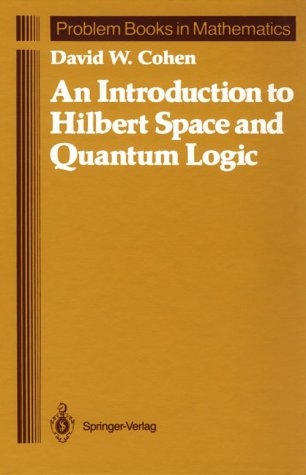
An Introduction to Hilbert Space and Quantum Logic
Springer-Verlag New York Inc.
978-0-387-96870-4 (ISBN)
- Titel ist leider vergriffen;
keine Neuauflage - Artikel merken
1. Experiments, Measure, and Integration.- A. Measures.- Experiments and weight functions, expected value of a weight function, measures, Lebesgue measure, signed measures, complex measures, measurable functions, almost everywhere equality..- B. Integration.- Simple functions, simple integrals, general integrals, Lebesgue integrals, properties of integrals, expected values as integrals, complex integrals..- 2. Hilbert Space Basics.- Inner product space, norm, orthogonality, Pythagorean theorem, Bessel and Cauchy-Schwarz and triangle inequalities, Cauchy sequences, convergence in norm, completeness, Hilbert space, summability, bases, dimension..- 3. The Logic of Nonclassical Physics.- A. Manuals of Experiments and Weights.- Manuals, outcomes, events, orthogonality, refinements, compatibility, weights on manuals, electron spin, dispersion-free weights, uncertainty..- B. Logics and State Functions.- Implication in manuals, logical equivalence, operational logic, implication and orthocomplementation in the logic, lattices, general logics (quantum logics), propositions, compatibility, states on logics, pure states, epistemic and ontological uncertainty..- 4. Subspaces in Hilbert Space.- Linear manifolds, closure, subspaces, spans, orthogonal complements, the subspace logic, finite projection theorem, compatibility of subspaces..- 5. Maps on Hilbert Spaces.- A. Linear Functional and Function Spaces.- Linear maps, continuity, boundedness, linear functional, Riesz representation theorem, dual spaces, adjoints, Hermitian operators..- B. Projection Operators and the Projection Logic.- Projection operators, summability of operators, the projection logic, compatibility and commutativity..- 6. State Space and Gleason's Theorem.- A. The Geometry of State Space.- State space, convexity, faces, extreme points, properties, detectability, pure states, observables, spectrum, expected values, exposed faces..- B. Gleason's Theorem.- Vector state, mixture, resolution of an operator into projection operators, expected values of operators, Gleason's theorem..- 7. Spectrality.- A. Finite Dimensional Spaces, the Spectral Resolution Theorem.- Eigenvalues, point spectrum, eigenspaces, diagonalization, the spectral resolution theorem..- B. Infinite Dimensional Spaces, the Spectral Theorem.- Spectral values, spectral measures, the spectral theorem, functions of operators, commutativity and functional relationships between operators, commutativity and compatibility of operators..- 8. The Hilbert Space Model for Quantum Mechanics and the EPR Dilemma.- A. A Brief History of Quantum Mechanics.- B. A Hilbert Space Model for Quantum Mechanics.- Schroedinger's equation, probability measures, stationary states, the harmonic oscillator, the assumptions of quantum mechanics, position and momentum operators, compatibility..- C. The EPR Experiment and the Challenge of the Realists.- Electron spin, spin states, singlet state, EPR apparatus, the EPR dilemma..- Index of Definitions.
| Erscheint lt. Verlag | 1.5.1989 |
|---|---|
| Reihe/Serie | Problem Books in Mathematics |
| Zusatzinfo | biography |
| Verlagsort | New York, NY |
| Sprache | englisch |
| Gewicht | 395 g |
| Einbandart | gebunden |
| Themenwelt | Mathematik / Informatik ► Mathematik ► Analysis |
| Naturwissenschaften ► Physik / Astronomie ► Allgemeines / Lexika | |
| ISBN-10 | 0-387-96870-9 / 0387968709 |
| ISBN-13 | 978-0-387-96870-4 / 9780387968704 |
| Zustand | Neuware |
| Haben Sie eine Frage zum Produkt? |
aus dem Bereich


